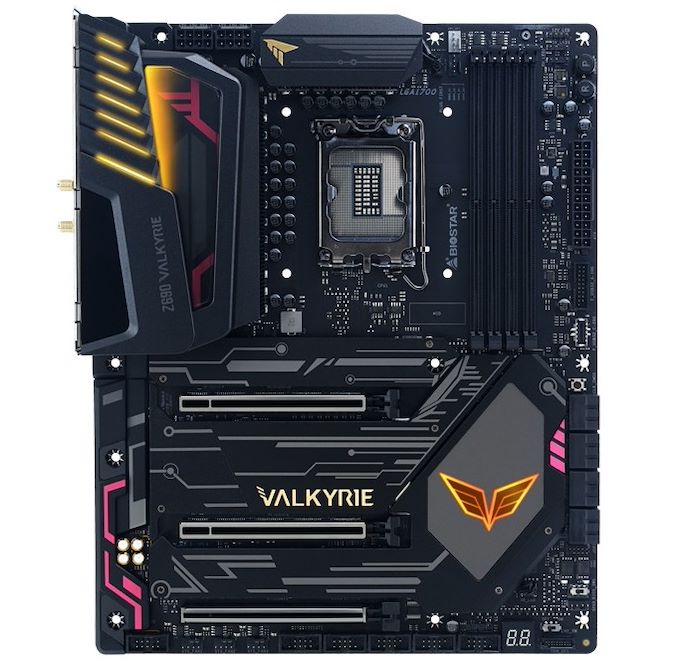The Intel Z690 Motherboard Overview (DDR5): Over 50+ New Models
by Gavin Bonshor on November 9, 2021 9:00 AM ESTBiostar Z690 Valkyrie (DDR5)
Despite not having a large stack at the moment, Biostar has launched three Z690 models for Intel's Alder Lake desktop platform. The most premium of these and subsequently the only one of the three that has support for DDR5 memory is the Z690 Valkyrie. The Biostar Z690 Valkyrie has a sort of 'anime' look to it, with a primarily black theme and colorful elements with RGB enabled backlighting in the rear panel cover and chipset heatsink. The Z690 Valkyrie combines a decent controller set, along with all the typical Z690 and 12th gen features such as PCIe 5.0, and of course support for the latest DDR5 memory.
The Biostar Z690 Valkyrie has plenty of PCIe slot expansion slot real estate, including two full-length PCIe 5.0 slots that can operate at x16 and x8/x8, with a third full-length PCIe 4.0 x4 slot. Storage options include a total of four PCIe M.2 slots, including three PCIe 4.0 x4 M.2 slots, one PCIe 3.0 x4 M.2 slot, and eight SATA ports. Biostar also includes four memory slots which can be found in the top right-hand corner, with support for DDR5-6000 and a maximum capacity of up to 128 GB.
On the rear panel is a high-speed USB 3.2 G2x2 Type-C port and a total of seven USB 3.2 G2 Type-A, with plenty of options for integrated graphics. For those users, Biostar includes two DisplayPort 1.4 and two HDMI 2.0 video outputs which shows lots of potential integrated GPU support. On the networking front, there's one Realtek RTL8125B 2.5 GbE port, and although it has the connectors for a Wi-Fi 6E CNVi, Biostar isn't clear on whether the Z690 Valkyrie actually includes the CNVi; the rear panel says yes, but the specifications say no Wi-Fi 6E card is included. Finishing off the rear panel are five 3.5 mm audio jacks and S/PDIF optical output powered by a Realtek ALC1220 HD audio codec, as well as a PS/2 combo port.












126 Comments
View All Comments
DanNeely - Tuesday, November 9, 2021 - link
Good point. I thought Intel was pushing hard for 12vo with the 6xx series, but it seems to be completely MIA.Silver5urfer - Tuesday, November 9, 2021 - link
Can I ask why ? What does ATX12VO provide to a consumer ?It doesn't make your mobo cheap, it doesn't make your mobo less complicated, it does not make your system run cooler, it doesn't make ADL consume less power, It doesn't even make any sense.
ATX12VO was created because of that trash policies set by policing state of California about some nonsensical rubbish. Servers and Data centers can get away with modular high density PSUs because of fully standardized set and they also get 3M liquid cooling. This is consumer market and here we have people wishing for backwards in technology.
meacupla - Thursday, November 11, 2021 - link
A lot of people had the same sentiment about EU RoHS restrictions, and yet, it was implemented worldwide.With that attitude, the same can be said about energy star, and 80plus certifications. It adds cost to the product, yet it offers not a thing to the consumer.
Not everything is about you.
We need to do everything we can to cut down power consumption, and ATX12VO standardization across the entire industry is very low hanging fruit.
Stop being so selfish, there's literally only one habitable planet we have right now.
Oxford Guy - Thursday, November 11, 2021 - link
80 Plus offered plenty to consumers. Less power use means quieter PSUs.The knock on 80 Plus was unrealistically easy testing. Despite that, it helped raise the efficiency of PSUs. Along with better efficiency, ripple, holdout time, voltage consistency, and other factors improved — as enthusiasts began to pay more attention to PSU quality.
I don’t doubt that 80 Plus also helped a lot of non-enthusiasts/amateurs by keeping them away from ultra-cheap PSUs that catch fire. Having a high-profile certification that those PSUs can’t reach helped to steer those customers away.
yacoub35 - Tuesday, November 9, 2021 - link
That white metal trim running tight around the molex power connector on the ASUS ROG Maximus Z690 Formula must make it an absolutely nightmare to plug/unplug the main power cable to the board.Ranguvar - Tuesday, November 9, 2021 - link
Correction:"Previously with 11th gen (Rocket Lake), Intel upheaved it from a PCIe 3.0 x4 uplink on Z490 to a PCIe 3.0 x4 uplink on Z590."
This should say "to a PCIe 3.0 x8 uplink on Z590".
OFelix - Tuesday, November 9, 2021 - link
Correct. And whilst we are correcting that sentence - "upheaved" ????This first page really needs to be read by an AnandTech editor.
What's that? They don't any editors? :-(
OFelix - Tuesday, November 9, 2021 - link
"Z490 Motherboard Audio" ... presumably Z690?mode_13h - Friday, November 12, 2021 - link
I caught that, as well. Even the word "upheaved" is itself somewhat noteworthy. Plenty of better alternatives: "upgraded", "widened", "expanded", "increased", "enlarged", etc.GeoffreyA - Saturday, November 13, 2021 - link
While "upheaved" is likely an error, it's not far off from the words of today. Unfortunately, the English language is on a downgrade, and it's just going to get worse and worse. The language's genius is not tuned to the over-economical forms we're finding today; and a lot of it seems to be coming from tech. Upthis, upthat. My favourite, though, is leverage. A big, scary word that companies are fond of, and which escaped its programming, game development roots. Soon, we'll be leveraging the kettle to make tea. How about using?